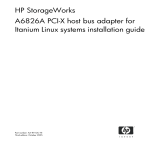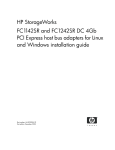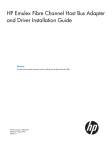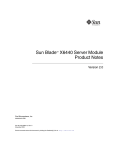Download Qlogic FIBRE CHANNEL HBA Specifications
Transcript
HP StorageWorks QLogic Fibre Channel host bus adapters for ProLiant and Integrity servers using Linux and VMware operating systems release notes Part number: AA-RWFNE-TE Thirteenth edition: March 2009 Description These release notes contain driver, firmware, and other supplemental information for the QLogic Fibre Channel host bus adapters (HBAs) for ProLiant and Integrity servers using Linux and VMware ® operating systems. See Product models for a list of supported HBAs. What's new? • RHEL 5 U3 using in-box driver • Multipath failover using Device Mapper Multipath • HBAnyware Prerequisites Before you perform HBA updates, you must: • Ensure that the system is running one of the operating system versions in “Operating systems” on page 4. • Starting with RHEL 5 U3, fibre channel HBAs and mezzanine cards are supported by Red Hat inbox drivers (provided as part of the O/S distribution), and multipath failover is now handled by Device Mapper. • See the HP server PCI slot specifications to determine if your server is compatible with these HBAs. • If you are installing the Linux operating system for the first time, load the operating system and then download and install the supported Linux HBA driver from the HP website: http://welcome.hp.com/country/us/en/support.html. Product models The following HBAs and Mezzanine Cards Support Linux on ProLiant servers: • • • • • • • • • • HP HP HP HP HP HP HP HP HP HP StorageWorks 81Q PCIe FC HBA (product number AK344A) StorageWorks 82Q PCIe FC HBA (product number AJ764A) StorageWorks FC1242SR PCI Express HBA (product number AE312A) StorageWorks FC1243 PCI-X 2.0 4Gb HBA (product number AE369A) StorageWorks FCA2214 PCI-X HBA (product number 281541-B2) StorageWorks FCA2214 DC PCI-X HBA (product number 321835-B21) BL20p G2 FC p-class Mezzanine Adapter (product number 300874-B21) BL20p G3, G4 p-class FC Mezzanine Adapter (product number 361426-B21) BL30p/BL35p p-class Dual-Port FC Mezzanine Adapter (product number 354054-B21) BL25p/BL45p p-class G2 FC Mezzanine Adapter (product number 381881-B21) The following HBAs and Mezzanine HBAs support Linux on BOTH ProLiant and Integrity Servers: • HP StorageWorks FC1143 PCI-X 2.0 4Gb HBA (product number AB429A) • HP StorageWorks FC1142SR PCI Express HBA (product number AE311A) • HP QLogic QMH2462 4Gb FC HBA for HP c-Class BladeSystem (product number 403619-B21) HP StorageWorks QLogic Fibre Channel host bus adapters for ProLiant and Integrity servers using Linux and VMware operating systems release notes 3 The following HBAs support Linux only on Integrity servers: • HP PCI-e dual-port 4Gb FC adapter (product number AD300A) • HP PCI-X dual-port 4Gb FC adapter (product number AB379A) • HP PCI-X dual-port 4Gb FC adapter (product number AB379B) • HP Q2300 PCI-X 2GB FC HBA (product number A7538A) • HP A6826A PCI-X Dual Port 2GB FC HBA (product number A6826A) Devices supported The QLogic HBAs for Linux are supported on HP servers that support: • the Linux operating systems described in Operating systems. • the servers listed on the HP website: http://www.hp.com/products1/serverconnectivity/support_matrices.html. • B-Series, C-Series, M-series and 8Gb Simple SAN Connection switch products. For the latest information, see the HP support website: http://welcome.hp.com/country/us/en/support.html, as well as the HP StorageWorks SAN design reference guide at http://h18006.www1.hp.com/ products/storageworks/san/documentation.html. • the following storage arrays: • Modular Smart Array 1000 • Modular Smart Array 1500 • Enterprise Virtual Array 3000/5000 GL • Enterprise Virtual Array 4000/4100/4400/6000/6100/8000/8100 • XP128/1024, XP10000/12000 and XP20000/24000 • MSA2000 is supported starting with RHEL5 U1, and SLES10 SP1 using Device Mapper failover. • MSA1000 and MSA1500 are not supported with the 81Q or 82Q HBAs with RHEL 4U5 or RHEL 4U6. • MSA1000 and MSA1500 are not supported in Active/Passive mode with SLES10 SP2. NOTE: Starting with RHEL5 U3 and SLES10 SP3, active/passive MSA and EVA arrays are no longer supported. Linux operating systems Linux on ProLiant The following versions of Linux are supported on ProLiant servers. Table 1 lists software support with the following 2.6 versions of x86 and x64 Linux: RHEL 5 U3 (2.6.18.128). HBAs Driver BIOS Multi-boot image SANsurfer 81Q (AK344A) 8.02.00.06.05.03-k 2.02 2.03 5.0.1b41 4 82Q (AJ764A) 8.02.00.06.05.03-k 2.02 2.03 5.0.1b41 FC1242SR (AE312A) 8.02.00.06.05.03-k 2.0 1.73 5.0.1b41 FC1142SR (AE311A) 8.02.00.06.05.03-k 2.0 1.73 5.0.1b41 FC1243 (AE369A) 8.02.00.06.05.03-k 2.0 1.73 5.0.1b41 FC1143 (AB429A) 8.02.00.06.05.03-k 2.0 1.73 5.0.1b41 FCA2214 8.02.00.06.05.03-k 1.45 n/a 5.0.1b41 FCA2214DC 8.02.00.06.05.03-k 1.45 n/a 5.0.1b41 QMH2462 c-Class Mezz 8.02.00.06.05.03-k 2.08 1.76af 5.0.0b41 HP BL20p G3, G4 FC 8.02.00.06.05.03-k 1.45 n/a 5.0.0b41 HP BL25p/BL45p G2 8.02.00.06.05.03-k 1.48 n/a 5.0.0b41 HP BL30p/BL35p DualPort FC Mezz 8.02.00.06.05.03-k 1.45 n/a 5.0.0b41 HP BL20p G2 FC Mezz 8.02.00.06.05.03-k 1.45 n/a 5.0.0b41 nl Table 2 lists the Linux versions that are supported on servers with 8Gb HBAs that have a minimum kernel of RHEL 4 U5 (2.6.9-55), RHEL 4 U6 (2.6.9-67), RHEL5 U1 (2.6.18-53), RHEL5 U2 (2.6.18-92), SLES9 SP3 (2.6.5-7.286), SLES9 SP4 (2.6.5-7.308), SLES10 SP1 (2.6.16.54-0.2.3) and SLES10 SP2 (2.6.16.60-0.21). Boot from SAN (BFS) is not supported with SLES9 SP3 and RHEL4 U5. Driver <BIOS Multi-boot image SANsurfer 81Q (AK344A) 8.02.11 2.02 2.03 5.0.1b31 82Q (AJ764A) 8.02.11 2.02 2.03 5.0.1b31 Table 3 lists software support with the following 2.6 versions of x86 and x64 Linux: RHEL4 U5 and U6, RHEL5 U1 and U2, SLES9 SP3 and SP4, SLES10 SP1 and SLES10 SP2. HBAs Driver BIOS Multi-boot image SANsurfer Utiliy FC1242SR (AE312A) 8.02.11 2.00 1.73 5.0.1b31 FC1142SR (AE311A) 8.02.11 2.00 1.73 5.0.1b31 FC1243 (AE369A) 8.02.11 2.00 1.73 5.0.1b31 FC1143 (AB429A) 8.02.11 2.00 1.73 5.0.1b31 FCA2214 8.02.11 1.45 n/a 5.0.1b31 FCA2214DC 8.02.11 1.45 n/a 5.0.1b31 QMH2462 c-Class Mezz 8.01.07.25 1.26 1.64 5.0.0b32 HP BL20p G3, G4 FC 8.01.07.25 1.45 n/a 5.0.0b32 HP BL25p/BL45p G2 8.01.07.25 1.48 n/a 5.0.0b32 HP StorageWorks QLogic Fibre Channel host bus adapters for ProLiant and Integrity servers using Linux and VMware operating systems release notes 5 nl HP BL30p/BL35p Dual-Port FC Mezz 8.01.07.25 1.45 n/a 5.0.0b32 HP BL20p G2 FC Mezz 8.01.07.25 1.45 n/a 5.0.0b32 The minimum supported 2.6 kernel versions are RHEL4 U5 (2.6.9-55), RHEL4 U6 (2.6.9-67), RHEL5 U1 (2.6.18-53), RHEL5 U2 (2.6.18-92), SLES9 SP3 (2.6.5-7.286), SLES9 SP4 (2.6.5-7.308), SLES10 SP1 (2.6.16.54-0.2.3) and SLES10 SP2 (2.6.16.60-0.21). Table 4 lists software support with the following 2.4 versions of x86 and x64 Linux: RHEL3 U8 and U9 and SLES8 SP4. HBA RHEL 3 Driver SLES 8 Driver BIOS Multi-boot image SANsurfer Utility FC1242SR (AE312A) 7.07.05.08 7.07.05.02 1.26 1.64 5.0.0b14 (.02 driver) 5.0.0b22 (.08 driver) FC1142SR (AE311A) 7.07.05.08 7.07.05.02 1.26 1.64 5.0.0b14 (.02 driver) 5.0.0b22 (.08 driver) QMH2462 c-Class Mezz 7.07.05.08 7.07.05.02 1.26 1.64 5.0.0b14 (.02 driver) 5.0.0b22 (.08 driver) FC1243 (AE369A) 7.07.05.08 7.07.05.02 1.26 1.64 5.0.0b14 (.02 driver) 5.0.0b22 (.08 driver) FC1143 (AB429A) 7.07.05.08 7.07.05.02 1.26 1.64 5.0.0b14 (.02 driver) 5.0.0b22 (.08 driver) FCA2214 7.07.05.08 7.07.05.02 1.45 n/a 5.0.0b14 (.02 driver) 5.0.0b22 (.08 driver) FCA2214DC 7.07.05.08 7.07.05.02 1.45 n/a 5.0.0b14 (.02 driver) 5.0.0b22 (.08 driver) nl HP BL20p G3, G4 FC 7.07.05.08 7.07.05.02 1.45 n/a 5.0.0b14 (.02 driver) 5.0.0b22 (.08 driver) HP BL25p/BL45p G2 7.07.05.08 7.07.05.02 1.48 n/a 5.0.0b14 (.02 driver) 5.0.0b22 (.08 driver) HP BL30p/BL35p Dual-Port FC Mezz 7.07.05.08 7.07.05.02 1.45 n/a 5.0.0b14 (.02 driver) 5.0.0b22 (.08 driver) 7.07.05.08 7.07.05.02 1.45 n/a 5.0.0b14 (.02 driver) 5.0.0b22 (.08 driver) nl nl nl nl nl nl nl nl nl nl nl nl nl nl nl HP BL20p G2 FC Mezz nl nl 6 nl Linux on Integrity The following versions of Linux are supported on Integrity servers: Table 5 lists software support with the following 2.6 versions of Itanium Linux: RHEL4 U5 and U6, RHEL5 U1 and U2, SLES9 SP3 and SP4, SLES10 SP1 and SLES10 SP2. HBA Driver EFI EFI utility Multi-boot image SANsurfer utility AD300A 8.02.11 2.00 2.48 1.73 5.0.1b31 AB379A 8.02.11 2.00 2.48 1.73 5.0.1b31 AB379B 8.02.11 2.00 2.48 1.73 5.0.1b31 AB429A 8.02.11 2.00 2.48 1.73 5.0.1b31 A6826A 8.02.11 1.49 2.07 n/a 5.0.1b31 A7538A 8.02.11 1.49 2.07 n/a 5.0.1b31 QMH2462 4Gb c-Class Mezz 8.01.07.25 1.09 2.30 1.64 5.0.0b32 The minimum supported 2.6 kernel versions are RHEL4 U5 (2.6.9-55), RHEL4 U6 (2.6.9-67), RHEL5 U1 (2.6.18-53), RHEL5 U2 (2.6.18-92), SLES9 SP3 (2.6.5-7.286), SLES9 SP4 (2.6.5-7.308), SLES10 SP1 (2.6.16.54-0.2.3) and SLES10 SP2 (2.6.16.60-0.21) . Table 6 lists software support with the following 2.4 versions of Itanium Linux: RHEL3 release U8 and U9 . HBA RHEL 3 Driver EFI EFI utility Multi-boot image SANsurfer utility A6826A 7.07.05.08 1.49 2.07 n/a 5.0.0b22 A7538A 7.07.05.08 1.49 2.07 n/a 5.0.0b22 VMware HP fully supports the use of Windows and Linux as a guest OS on VMware ESX versions 2.5.x and 3.x. When running VMware, fibre channel HBAs are supported by in-box drivers supplied with ESX. Windows and Linux FC HBA drivers are not used on the Virtual O/S. NOTE: You do not need to install the QLogic driver since it is shipped in-box with the ESX server. To insure that your HBA is fully supported by HP and VMware, refer to one of the following websites: For VMware ESX version 3.x, see the website: HP StorageWorks QLogic Fibre Channel host bus adapters for ProLiant and Integrity servers using Linux and VMware operating systems release notes 7 http://www.vmware.com/support/pubs/vi_pages/vi_pubs_35.html Table 7 lists software support with the following 2.4versions of x86 ESX server: 3.5 US build 110268 HBA Driver BIOS >Multi-boot image SANsurfer utility QLE2462 7.08–vm33.1 2.02 1.73af 5.0.1b34 QLE2460 7.08–vm33.1 2.02 1.73af 5.0.1b34 QLA2462 7.08–vm33.1 2.02 1.73af 5.0.1b34 QLA2460 7.08–vm33.1 2.00 1.73f 5.0.1b34 QLE2562 7.08–vm33.1 2.02 2.03af 5.0.1b34 QLE2560 7.08–vm33.1 2.02 2.03af 5.0.1b34 QMH2462 7.08–vm33.1 1.26 1.64 5.0.1b34 Table 8 lists software support with the following 2.4versions of x86 Esx server: 3.5 US build 123630 HBA Driver BIOS Multi-boot image >SANsurfer utility QLE2462 7.08–vm33.3 2.02 1.73af 5.0.1b34 QLE2460 7.08–vm33.3 2.02 1.73af 5.0.1b34 QLA2462 7.08–vm33.3 2.02 1.73af 5.0.1b34 QLA2460 7.08–vm33.3 2.00 1.73f 5.0.1b34 QLE2562 7.08–vm33.3 2.02 2.03af 5.0.1b34 QLE2560 7.08–vm33.3 2.02 2.03af 5.0.1b34 QMH2462 7.08–vm33.1 1.26 1.64 5.0.1b34 Table 9 lists software support with the following 2.4 versions of x86 ESX server: 3.5 US build xxxxxx HBA Driver BIOS Multi-boot image SANsurfer utility QLE2462 7.08–vm66 2.08 1.73af 5.0.1b34 QLE2460 7.08–vm66 2.08 1.73af 5.0.1b34 QLA2462 7.08–vm66 2.08 1.73af 5.0.1b34 QLA2460 7.08–vm66 2.08 1.73af 5.0.1b34 QLE2562 7.08–vm66 2.08 2.03af 5.0.1b34 QLE2560 7.08–vm66 2.08 2.03af 5.0.1b34 QMH2462 7.08–vm66 2.08 1.64 5.0.1b34 8 Boot from SAN on VMware To perform a Boot from SAN on VMware, see the document, HP StorageWorks Fibre Channel host bus adapters software guide for Linux at the website http://bizsupport2.austin.hp.com/bc/docs/ support/SupportManual/c01672721/c01672721.pdf. Installing the driver You do not need to install the QLogic driver since it ships in-box with the ESX server. NOTE: VMware ESX 3.x.x is not supported on the IA64 architecture. Installing the Linux device driver using Red Hat in-box driver For instructions on how to install Linux while using the in-box drivers, see the HP website: http:// www.hp.com, then search for device mapper + boot + san. You will need to install the HP-supplied Device Mapper Multipath Kit, after installing the operating system, should a multiple path redundancy need exist. See the HP website: http://www.hp.com/go/ devicemapper You will also need to install the new hp-fc-enablement kit, after installing the operating system. HP Fibre Channel Enablement Kit The HP Fibre Channel Enablement Kit provides additional libraries and configuration utilities to enable HP StorageWorks fibre channel storage arrays to work with Linux. The Fibre Channel Enablement Kit is not required to use the lpfc and qla2xxx kernel modules but it does provide configuration scripts to make sure that they the correct settings to work with HP StorageWorks fibre channel arrays. The Fibre Channel Enablement kit also sets the correct lpfc and qla2xxx kernel module setting that are used with Device Mapper Multipathing. NOTE: If you are using any HP managmenet applications you will need the HBAAPI libraries that come with the hp-fc-enablement RPM. Installing the HP Fibre Channel Enablement Kit To install the HP Fibre Channel Enablement Kit, do the following: 1. 2. Download the hp-fc-enablement-yyyy-mm-dd.tar.gz file for your operating system and copy it to the target server Untar the enablement kit by executing the command to create the directory, hp-fc-enablementyyyy-mm-dd. # tar zxvf hp-fc-enablement-yyyy-mm-dd.tar.gz HP StorageWorks QLogic Fibre Channel host bus adapters for ProLiant and Integrity servers using Linux and VMware operating systems release notes 9 3. Browse to the directory hp-fc-enablement-yyyy-mm-dd. 4. Do one of the following to execute the install.sh script. a. If you are not using Device Mapper multipathing execute the following command: # ./install.sh -s b. If you are using Device Mapper multipathing execute the following command: # ./install.sh -m The hp-fc-enablement and fibreutils RPMs should be installed once this install completes. To verify the installation, enter the following commands: # rpm -q hp-fc-enablement # rpm -q fibreutils NOTE: For use with the driver that comes with the kernel you will need fibreutils 3.x or greater. Uninstall To uninstall the Fibre Channel Enablement Kit, untar the kit as mentioned in the installation steps 1 through 3, then execute the install.sh script with the following flag: # ./install.sh -u To uninstall the RPMs in the enablement kit manually, enter the commands: # rpm -e hp-fc-enablement # rpm -e fibreutils Installing HP supported QLogic driver (pre RHEL 5 U3) HP does not currently support the driver that comes with the Linux kernel. Instead, you need to install an appropriate driver from the Fibre Channel HBA website: http://h18006.www1.hp.com/storage/saninfrastructure/hba.html. To obtain the HBA driver, download the appropriate driver kit for your operating system. To install Linux on a BFS LUN with driver versions that are not supported by the initial O/S release, the new driver must be integrated as part of the installation process using a DD-kit. Driver failover mode If you use the INSTALL command with no flags, the driver’s failover mode depends on whether a QLogic driver is already loaded in memory, (i.e. listed in the output of the lsmod command). Possible driver failover mode scenarios include: • If an hp_qla2x00src driver RPM is already installed, then the new driver RPM will use the failover of the previous driver package. • If there is no QLogic driver module (qla2xxx module) loaded, the driver will default to failover mode. This is also true if an inbox driver is loaded that does not list output in the /proc/scsi/qla2xxx directory. 10 • If there is a driver that is loaded in memory that lists the driver version in /proc/scsi/qla2xxx but no driver RPM has been installed, then the driver RPM will load the driver in the failover mode that the driver in memory is currently in. Installation instructions 1. Download the appropriate driver kit for your distribution. The driver kit file will be in the format hp_qla2x00-yyyy-mm-dd.tar.gz. 2. Copy the driver kit to the target system. 3. Uncompress and untar the driver kit using the following command: # tar zxvf hp_qla2x00-yyyy-mm-dd.tar.gz 4. Change directory to the hp_qla2x00-yyyy-mm-dd directory. 5. Execute the INSTALL command. The INSTALL command syntax will vary depending on your configuration. If a previous driver kit is installed, you can invoke the INSTALL command without any arguments as the script will use the currently loaded configuration: # ./INSTALL To force the installation to failover mode, use the -f flag: # ./INSTALL -f To force the installation to single-path mode, use the -s flag: # ./INSTALL -s Use the -h option of the INSTALL script for a list of all supported arguments. The INSTALL script will install the appropriate driver RPM for your configuration, as well as the appropriate fibreutils RPM. Once the INSTALL script is finished, you will either have to reload the QLogic driver modules (qla2xxx, qla2300, qla2400, qla2xxx_conf) or reboot your server. The commands to reload the driver are: # /opt/hp/src/hp_qla2x00src/unload.sh # modprobe qla2xxx_conf # modprobe qla2xxx # modprobe qla2300 # modprobe qla2400 The command to reboot the server is: # reboot CAUTION: If your boot device is a SAN attached device you will have to reboot your server. To verify which RPM versions are installed, use the rpm command with the -q option. For example: # rpm -q hp_qla2x00src HP StorageWorks QLogic Fibre Channel host bus adapters for ProLiant and Integrity servers using Linux and VMware operating systems release notes 11 # rpm –q fibreutils Installing the operating system using a DD-kit This section pertains to the 81Q and 82Q PCIe 8Gb HBAs. DD-kits for both Novell and Red Hat can be found in a single compressed file. The file will be located in the Driver - Storage Controllers - FC HBA section of the Download drivers and software page after selecting the HBA then the operating system to be installed. The files are in a ISO format that require expanding. Use a CD burner software to expand the ISO file matching the operating system being installed. Installing Novell SLES9 SP4 and SLES10 SP1 with a DD-kit 1. 2. 3. 4. Insert the Novell product CD #1 into the CD drive and boot the system. On the main installation screen, press F5. Three options appear: Yes, No, or File. Select Yes. Select an installation option, and press Enter. A prompt asking you to choose the driver update medium appears. 5. With the DD-kit CD in the CD drive, press Enter to start loading the driver update to the system. If the driver update was successful, the message, Driver Update OK will appear. 6. Press Enter. If the system prompts you to update another driver, click Back, then press Enter. A message asking you to make sure that CD #1 is in your drive appears. 7. 8. Insert CD #1 into the CD drive and press OK. Follow the on-screen instructions to complete the installation. Installing Red Hat RHEL4 U6 and RHEL5 U1 with a DD-kit 1. Insert Red Hat product CD #1 in the CD drive and boot the system. The system boots from the CD and stops at the boot prompt. 2. Enter Linux dd at the boot prompt, then press Enter. The message, Do you have a driver disk? appears. 3. 4. Click Yes, then press Enter. From the Driver Disk Source window, select the driver source: Select hdx (where x=CD drive letter), then press Enter. The Insert Driver Disk window displays. 5. 6. Insert the DD-kit disk into the CD drive. Click OK, then press Enter. This loads the driver update to the system. The Disk Driver window displays, prompting for more drivers to install. 7. 8. 9. Click No, then press Enter. Insert CD #1 in the drive and press OK. Follow the on-screen instructions to complete the installation. 12 Boot From SAN (BFS) and 8Gb Fibre Channel Host Bus Adapters (HBA) If you are using a Fibre Channel HBA that is capable of 8Gb transfer speeds and you are using either Red Hat Enterprise Linux 5.1 or earlier or SUSE Linux Enterprise Server (SLES) 10 Service Pack (SP) 1 or earlier, you must install the HP driver kit, before installing the ProLiant Support Pack (PSP), that you can download from the website: http://h18006.www1.hp.com/storage/saninfrastructure/hba.html The reason for this is that the Fibre Channel HBA drivers in PSP version 8.0 and earlier do not support Fibre Channel HBAs that are capable of transfer speeds of 8Gb. If you fail to install Fibre Channel HBA drivers that support these Fibre Channel HBAs, you may lose access to your boot device. If you plan to install the PSP and have your boot device out in the SAN, it is recommended that you perform the following steps: 1. 2. 3. Install the operating system. Install the HP driver kit for your Fibre Channel HBA Install the PSP. This will ensure that the driver loaded by the operating system will discover Fibre Channel HBAs that are capable of 8Gb transfer speeds. VMWare HP fully supports the use of Windows and Linux as a guest O/S on VMware ESX versions 2.5.x and 3.x. When running VMware, Fibre Channel HBAs are supported by embedded drivers supplied with ESX. Windows and Linux FC HBA drivers are not used. To insure that your HBA is fully supported by HP and VMware, please go to one of the websites below: For VMware ESX version 3.x, see the website: http://www.vmware.com/support/pubs/vi_pages/vi_pubs_35.html. For VMware ESX version 2.5.x, see the website: http://www.vmware.com/support/pubs/esx_pubs.html. Important information Presenting LUNs to a Linux host When presenting XP LUNs to a Linux host, • the LUNs must start with a LUN 0. • the LUNs must be presented across all paths that are connected/configured from the XP storage array. • If LUN 0 is not present, SANsurfer will show the XP array as offline. HP StorageWorks QLogic Fibre Channel host bus adapters for ProLiant and Integrity servers using Linux and VMware operating systems release notes 13 Driver auto-compilation supported What is auto-compilation? Auto-compilation is the ability to have the QLogic Fibre Channel HBA driver automatically compile itself when a new kernel is loaded. The advantage of having the QLogic FC HBA driver compile itself automatically is that an administrator will not have to manually invoke the driver compile scripts, so that the new kernel is running the HP-approved FC HBA driver for QLogic. How does auto-compilation work? Auto-compilation is achieved by adding a trigger script to the kernel-source and kernel-devel RPMs in both Red Hat and Novell Linux distributions. What a trigger script does is when either the kernel-source or kernel-devel RPMs are either installed or upgraded, a small script will run and see if the QLogic FC HBA driver needs to be compiled for the new kernel. This script is actually located in /opt/hp/src/hp_qla2x00src/smart_compile. What happens is this script is initially run when the hp_qla2x00src RPM is installed to take an inventory of kernels that have already been installed on the server. When the trigger script runs, it calls the smart compile script to compile the currently installed HP QLogic FC HBA driver for all the kernels that it does not have in its repository. Once smart_compile is finished compiling the driver for all the newly installed kernels, it updates it inventory of kernels so that it contains the new kernels it just compiled the driver for. Thus, if smart_compile is run again it won’t compile the drivers that it has already compiled the kernel for again. Example 1. Auto-compilation example An example of what would happen during an auto-compile is below: 1. 2. 3. 4. 5. User enables auto-compilation as specified in the section How to enable auto-compilation, page ?. User installs the actual kernel binary RPM. User installs the kernel development RPM (either kernel-source or kernel-devel). Trigger script is run. If auto-compilation has been enabled, then smart_compile is run. Auto-compilation script (smart_compile) compiles the QLogic FC HBA driver for the newly installed kernel The HP supported QLogic FC HBA driver will then load on next reboot. How to enable auto-compilation Auto-compilation of the QLogic driver is turned off by default. To enable auto-compilation, perform the following steps: 1. Change directory to /opt/hp/src/hp_qla2x00src. 2. Run the following command. # ./set_parm -a The script should then output that auto-compilation has been set to yes. If the output says that it has been set to no, simply rerun the set_parm -a command again as the -a switch simply toggles this functionality on and off. 14 How to disable auto-compilation 1. Change directory to /opt/hp/src/hp_qla2x00src. 2. Run the following command. # ./set_parm -a The script should then output that auto-compilation has been set to no. If the output says that it has been set to yes, simply rerun the set_parm -a command again as the -a switch simply toggles this functionality on and off. NOTE: When installing new kernels, in order for auto-compilation to work correctly, you must install the kernel rpm first, followed by the kernel development environment for the same kernel (kernel-source for SLES and kernel-devel for RHEL). Failure to do this will mean that the driver will not get compiled for the new kernel. NOTE: In order for auto-compile to work in RHEL 4, you must install the Kernel RPMs in the following order (perform steps 2 and3 if required). 1. kernel-<version>.<arch>.rpm 2. kernel-<smp/largesmp/hugemem>-<version>.<arch>.rpm 3. kernel-<smp/largesmp/hugemem>-devel-<version>.<arch>.rpm 4. kernel-devel-<version>.<arch>.rpm About warning messages During the Kernel upgrade process, the following messages can be ignored. RHEL 4 All Updates WARNING: No module qla2xxx_conf found for kernel 2.6.9-55.0.9.EL, continuing anyway SLES 10 All SPs WARNING: /lib/modules/2.6.18-8.1.8.el5/kernel/drivers/scsi/qla2xxx/qla2300.ko needs unknown symbol qla2x00_remove_one WARNING: /lib/modules/2.6.18-8.1.8.el5/kernel/drivers/scsi/qla2xxx/qla2300.ko needs unknown symbol qla2x00_probe_one WARNING: /lib/modules/2.6.18-8.1.8.el5/kernel/drivers/scsi/qla2xxx/qla2400.ko needs unknown symbol qla2x00_remove_one WARNING: /lib/modules/2.6.18-8.1.8.el5/kernel/drivers/scsi/qla2xxx/qla2400.ko needs unknown symbol qla2x00_probe_one HP StorageWorks QLogic Fibre Channel host bus adapters for ProLiant and Integrity servers using Linux and VMware operating systems release notes 15 x86_64 SANsurfer benign messages While the x86_64 SANsurfer RPM is installing, the following message may appear: Command.run(): process completed before monitors could start. This message can safely be ignored. SANsurfer will still install and run correctly. . Dynamic target addition not supported Dynamic target addition is defined as adding a new Fibre Channel target (such as adding a new storage array) to a SAN, presenting that new target to a Fibre Channel host bus adapter, and then prompting the operating system to do an online scan (such as using the hp_rescan utility that comes with fibreutils). This functionality is not supported with the QLogic failover driver. If you add a new Fibre Channel target to a host server, you must reboot that host server. scsi_info command on older XP arrays When running the scsi_info command on older XP arrays (such as the XP1024/128), you may see output similar to that shown in the following example. Ignore the error, and note that the XP array's WWN is not all zeros. The XP array returns INQUIRY data that differs slightly from that returned by EVA or MSA arrays. [root@coco /]# scsi_info /dev/sdal SCSI_ID="4,0,8,0": nl VENDOR="HP":MODEL="OPENE":FW_REV="5005":WWN="0000000000000000":LUN="5235303020303030-3130353930203030" [root@coco /]# scsi_info /dev/sdam SCSI_ID="4,0,8,1":VENDOR="HP":MODEL="OPENE":FW_REV="5005":WWN="0000000000000000":LUN="5235303020303030-3130353930203030" [root@coco /]# scsi_info /dev/sdan SCSI_ID="4,0,9,0":VENDOR="HP":MODEL="OPEN3":FW_REV="2114":WWN="03000000002018e9":LUN="5234353120303030-3330313033203030" [root@coco /]# scsi_info /dev/sdao SCSI_ID="4,0,9,1":VENDOR="HP":MODEL="OPEN3":FW_REV="2114":WWN="0b00000000600000":LUN="5234353120303030-3330313033203030" SANsurfer limitations • As a safety mechanism, the SANsurfer application does not retain any updates when the user abruptly quits using the Close/Exit button. Users must click on the Save button for any changes or edits made to the HBA. • Under certain conditions, some LUNS may not appear under the target in the left hand pane. Should this occur, refer to the LUNs displayed in the right hand pane. The O/S has visibility to all of the LUNs. The anomaly is the lack of LUNs being displayed under the target. This behavior is benign and may be ignored. • With V5.0.1b31, there are a small number of help file links that are in error. These will be fixed in the next SANsurfer release. 16 • After updating the HBA firmware or multiboot image a system reboot is required. Enabling extended error logging on 2GB cards The Enable Extended Error Logging feature on 2GB cards sets the bit in the /sys/module/qla2xxx/parameters but does not clear it when disabled. LUN Numbering Requirement When presenting LUNs from a specific storage array to a server, each LUN number must be unique. Specifically, all LUN numbers from a specific storage array to a specific server must be unique. This LUN numbering requirement includes presenting LUN's from the same storage array, but to different sets of HBA ports in the same server. Also, the LUN numbers must be consistent across all HBA ports for the same physical LUN. Controller Targets Require Data LUNs After configuring a controller target, you must present at least one data LUN to the server (controller LUNs cannot be presented alone, without a data LUN). XP load balancing Automatic dynamic load balancing is not supported on HP XP arrays. Compatibility and interoperability • The HBAs support the servers and switches described in “Devices supported” on page 4, and support the operating systems described in “Operating systems” on page 4. • HP recommends that you implement zoning by HBA, as described in HP StorageWorks SAN design reference guide, available on the website: http://h18006.www1.hp.com/products/storageworks/san/documentation.html. Determining the current version This section describes how to determine the HBA driver and firmware versions. Using SANsurfer To determine version information on Linux systems: 1. Open SANsurfer. 2. Click an HBA in the left pane to select it. 3. Click the Information tab in the right pane to view the HBA's version information. Using the Linux more command To determine version information on Linux systems enter the following more command: HP StorageWorks QLogic Fibre Channel host bus adapters for ProLiant and Integrity servers using Linux and VMware operating systems release notes 17 more /proc/scsi/qla2xxx/* For 81Q and 82Q only HP StorageWorks Simple SAN Connection Manager (SSCM) is supported on the Windows based management server and connects to the qlremote agent on the Linux server. Languages American English Effective date March 2009 18


























